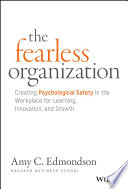

Psychological safety is the cornerstone of a fearless organization. It refers to a shared belief that the team is safe for interpersonal risk-taking. In environments where psychological safety is cultivated, team members feel comfortable expressing their thoughts, ideas, and concerns without fear of negative consequences. This fosters open communication and innovation, as employees are more likely to share creative solutions and challenge the status quo. The book emphasizes that leaders play a crucial role in establishing this culture by modeling vulnerability, encouraging input from all team members, and actively listening to feedback. Organizations that prioritize psychological safety see improvements in collaboration, engagement, and overall performance.
Continue readingLeaders are pivotal in creating and maintaining psychological safety within teams. The book outlines specific behaviors that leaders should adopt to foster this environment, such as being approachable, demonstrating humility, and showing appreciation for diverse perspectives. By doing so, leaders can create a culture where employees feel valued and empowered. The text also discusses the importance of leadership training and development programs that focus on emotional intelligence and communication skills. Effective leaders not only support their team's well-being but also drive organizational success by harnessing the collective intelligence of their workforce.
Continue readingA fearless organization views failure as a learning opportunity rather than a setback. The book argues that when employees feel safe to take risks, they are more likely to experiment and innovate. This culture of experimentation leads to valuable insights and improvements over time. The author discusses the importance of debriefing after projects or initiatives to analyze what went well and what could be improved. This reflective practice encourages a growth mindset and reinforces the idea that mistakes are part of the learning process. Organizations that embrace this philosophy are more resilient and adaptable in the face of change.
Continue readingDiversity and inclusion are essential components of a fearless organization. The book highlights how diverse teams are more innovative and effective, as they bring a variety of perspectives and experiences to the table. However, for diversity to be truly impactful, organizations must create an inclusive environment where all voices are heard and valued. This involves actively seeking out diverse talent, promoting equitable practices, and ensuring that everyone has equal access to opportunities. The author emphasizes that inclusivity enhances psychological safety, as employees from all backgrounds feel respected and empowered to contribute.
Continue readingA strong feedback culture is vital for fostering psychological safety and continuous improvement. The book discusses how organizations can implement regular feedback mechanisms that encourage open dialogue between employees and leaders. This includes formal processes like performance reviews as well as informal check-ins. By normalizing feedback, organizations can help employees feel more comfortable sharing their thoughts and ideas. The text also emphasizes the importance of delivering feedback constructively and with empathy, ensuring that it is seen as a tool for growth rather than criticism.
Continue readingEffective team dynamics are crucial for creating a fearless organization. The book explores how collaboration and trust among team members contribute to a psychologically safe environment. It discusses strategies for building strong relationships within teams, such as team-building activities, open communication practices, and conflict resolution techniques. When team members trust one another, they are more likely to take risks and share their ideas freely. The author also highlights the importance of recognizing and addressing any toxic behaviors that may undermine team cohesion and safety.
Continue readingCreating a fearless organization is not a one-time effort; it requires ongoing commitment and reinforcement. The book outlines strategies for sustaining a culture of psychological safety over time, including regular assessments of team dynamics, continuous leadership development, and celebrating successes. Leaders are encouraged to stay vigilant and proactive in addressing any issues that may arise, as complacency can lead to a decline in psychological safety. By continuously nurturing this culture, organizations can ensure long-term success and resilience in an ever-changing business landscape.
Continue reading